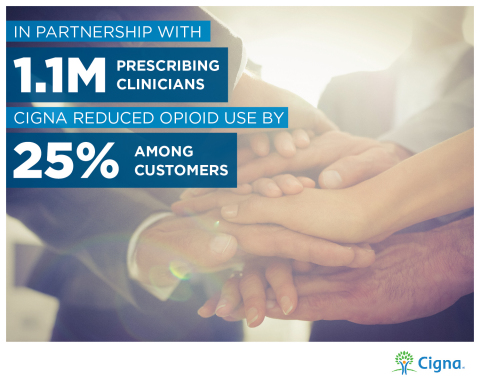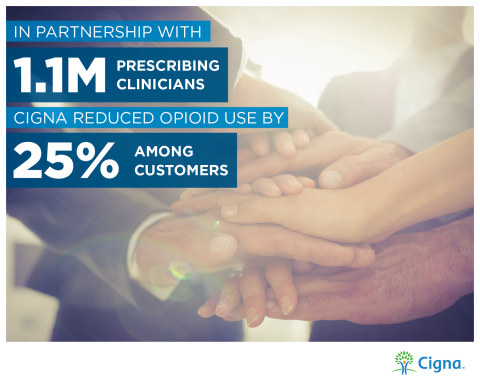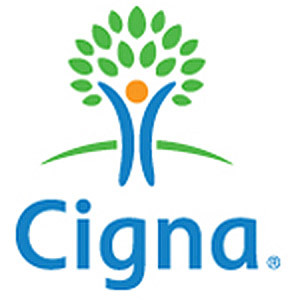BLOOMFIELD, Conn.--(BUSINESS WIRE)--Cigna (NYSE: CI) today announced that in partnership with more than 1.1 million prescribing clinicians, the global health service company has achieved a 25 percent reduction in opioid use among its customers, reaching this key metric one year ahead of its ambitious initial goal. The broad based effort meaningfully contributes to curbing the opioid epidemic, which has taken thousands of lives, sidelined millions of workers and diverted billions of dollars in the United States.
In May 2016, Cigna brought together resources across its medical, behavioral and pharmacy programs to identify ways that the company could harness its physician-partnership model to interrupt the cycle of addiction while assuring that people who have no alternatives to manage their pain retained clinically appropriate access to the remedies prescribed by their doctor. One key metric in the effort was to reduce opioid use among its customers by 25 percent by 2019. The company selected 25 percent because this reduction would return customers’ usage of opioids to pre-epidemic levels.
“We committed to this reduction for our customers because we recognized the severity of the epidemic and its impact on people from every walk of life, their families, employers and communities,” said David M. Cordani, Cigna President and Chief Executive Officer. “We are proud that we achieved this goal early, but even more importantly, we did so by enhancing patient support and ensuring our customers have access to the right care at the right time. There is still much more work to do, and we are focused on continuing to push forward on these efforts every day.”
To track against the 25 percent metric, Cigna measured the total volume of opioids being prescribed based on morphine milligram equivalent doses, taking into account the number of pills, the dosing of those pills, as well as the relative strengths of the different opioid medications. Cigna collaborated with physicians, dentists, patient awareness and support organizations in local communities to identify immediate and longer-term approaches that increased safeguards in the opioid prescribing process, enhanced support and counseling, and made it easier to access treatments for substance use disorders. Specifically, the company:
- Convened more than 2,000 medical groups representing more than 65,000 doctors in a focused effort to reduce opioid prescribing and to treat opioid use disorder as a chronic condition, one patient at a time.
- Notified physicians of risks of possible misuse or overuse, suggested by an integrated analysis of pharmacy, medical and mental health (behavioral) benefits.
- Engaged with more than 85,000 prescribers annually whose patients have a concerning pattern of opioid prescription use to ensure that prescriptions are appropriate, medically necessary and safe for the patient.
- Worked closely with clients to implement opioid utilization management solutions.
- Opened Cigna’s 24/7/365 free counseling helplines to all veterans and their caregivers, whether they are Cigna customers or not, to help this community which is particularly vulnerable in this national epidemic.
- Convened local leaders to better understand the impact of the epidemic in communities like New York, Houston and Los Angeles and identify solutions together that create greater awareness, more innovative treatments, and prevention.
“We collaborated with Cigna very early on, looking at the opioid prescription habits of our physicians and trying to get our practice more commensurate with national guidelines,” said Dr. John Bertini of Renaissance Physicians in Houston, Texas. “Cigna set itself apart because of their interest in the health of the patient. Clearly the inappropriate use of opioids is detrimental to the health of the patient, their family and the community on many levels. As we work together to address this problem, we are enhancing the health of the populations of patients that we collectively serve.”
In the United States, an estimated 2.5 million people suffer from substance use disorders related to prescription opioid pain relievers. Cigna recognizes that substance use disorders are complex, chronic conditions that are frequently accompanied by other behavioral or medical conditions. To address this growing health issue, the company tapped into its extensive experience with prevention, wellness and chronic disease management programs, and worked with clients, physicians, regulators, patient advocacy groups and others to develop ways to increase prevention and treatment of substance use disorders.
Cigna will expand an existing program that uses predictive analytics to identify patients who are more likely to suffer from an overdose and prompts interventions to help prevent the overdose from happening. These efforts will be targeted in key regions of the country that have been hit particularly hard by opioid overdoses.
This summer, Cigna is also instituting additional safety measures to further align with national and regional guidelines aimed at minimizing the risk of medications that are more likely to cause an opioid overdose. These measures include limiting the duration of certain opioid prescriptions and ensuring daily dosage measurements do not exceed safe quantities, as appropriate.
The company is also initiating a consumer-focused initiative focused on prevention. The campaign will educate Americans about pain, how it manifests, how it is treated and ultimately, how to manage it as safely as possible. The initiative is meant to better equip patients to have informed conversations with their health care providers about their pain and the risks and benefits associated with opioid prescriptions.
About Cigna
Cigna Corporation (NYSE: CI) is a global health service company dedicated to helping people improve their health, well-being and sense of security. All products and services are provided exclusively by or through operating subsidiaries of Cigna Corporation, including Cigna Health and Life Insurance Company, Connecticut General Life Insurance Company, Life Insurance Company of North America and Cigna Life Insurance Company of New York. Such products and services include an integrated suite of health services, such as medical, dental, behavioral health, pharmacy, vision, supplemental benefits, and other related products including group life, accident and disability insurance. Cigna maintains sales capability in 30 countries and jurisdictions, and has more than 95 million customer relationships throughout the world. To learn more about Cigna®, including links to follow us on Facebook or Twitter, visit https://www.cigna.com
HOW CIGNA IS TACKLING THE NATIONAL OPIOID EPIDEMIC: BY THE NUMBERS
Cigna has been aggressively fighting the crisis by reducing the use of opioids among our customers and collaborating with physicians and other parties to find workable solutions.
- 1st: national managed care organization to provide increased reimbursement to physicians for the induction phase of treatment with Suboxone, back in 2007.
- 25%: reduction of U.S. customers’ opioid use by 2019, committed by Cigna in May 2016, which would return customers’ usage back to a pre-epidemic level.
- 65,000 Physicians: Signed Cigna’s pledge (launched in November 2016) to reduce opioid prescriptions and treat opioid use disorders as chronic conditions representing more than 650 medical groups
- 2 years: of de-identified customer claims given from Cigna to the American Society of Addiction Medicine (ASAM) in May 2016 to create national standards to help providers evaluate how they’re performing and ensure that patients receive high-quality care.
- 24/7/365: Cigna opened its counseling helplines to veterans and their caregivers in 2017, whether they are Cigna customers or not, to help the veteran community who is severely impacted by the opioid epidemic.
Steps to Combat the Epidemic: Executing Pharmacy Changes and Engaging with Providers
- Cigna lifted prior authorization for medication-assisted treatment (MAT) to ensure availability for customers.
- 97%: of at-risk individuals expected to be identified if clinicians check local Prescription Drug Management Program (PDMP) databases when prescribing more than a 21-day supply of narcotic painkillers. Cigna now requires this check, and also actively tracks possible inappropriate use and informs prescribers when a potential issue is identified.
- Cigna provides physicians in its networks with profiles on how their prescribing habits compare with the Centers for Disease Control and Prevention (CDC) guidelines, as well as compare their prescribing habits with other doctors in their community.
- 85,000: Prescribers who we engage with annually whose patients have a concerning pattern of opioid prescription use to ensure that prescriptions are appropriate, medically necessary and safe for the patient.
Advocacy Partnerships with the Cigna Foundation
- $300,000: donated by the Cigna Foundation in July 2017 to the Iraq & Afghanistan Veterans of America (IAVA) for a three-year expansion of IAVA’s Rapid Response Referral Program
-
$200,000: donated by the Cigna Foundation to Shatterproof
(a national non-profit committed to protecting loved ones from a
dependence on illicit and prescription drugs and alcohol) for the
development of an online portal to help people understand, prevent,
intervene, treat and recover from substance use disorders.
- Cigna’s Chris Hocevar, president of strategy, segments and solutions, sits on the steering committee of Shatterproof’s Substance Use Disorder Treatment Task Force, which is developing a private sector-oriented plan to actualize the 2016 recommendations from the Surgeon General’s Report on Alcohol, Drugs, and Health.
- $50,000: donated by the Cigna Foundation to Pennsylvania District Attorneys Institute to make naloxone available for use by first responders in Pennsylvania.




